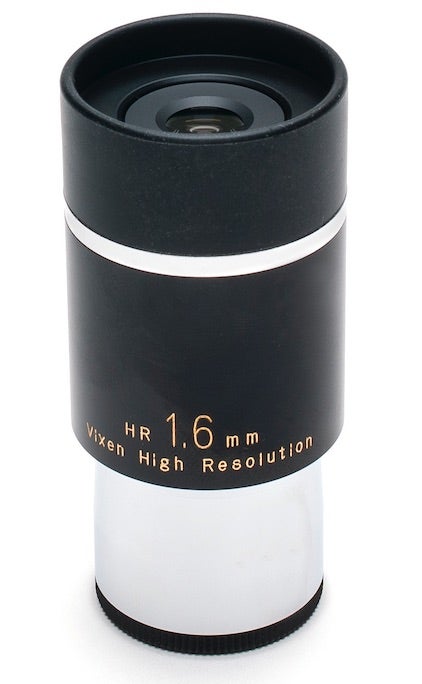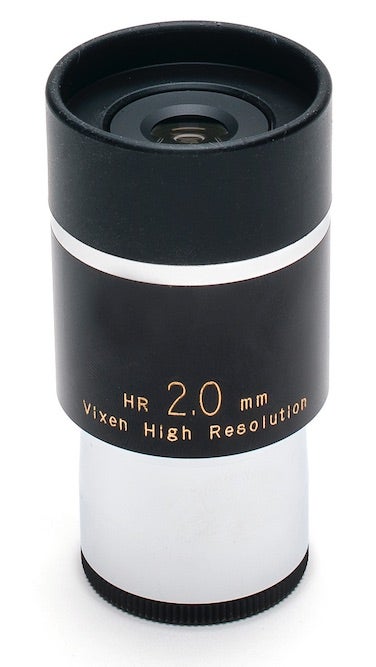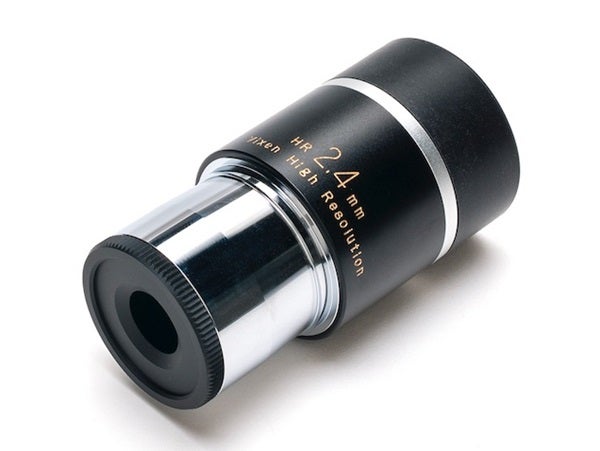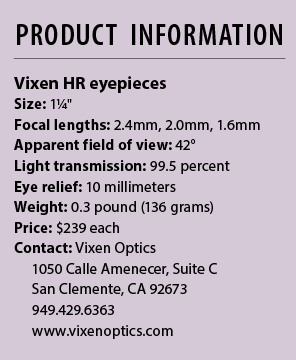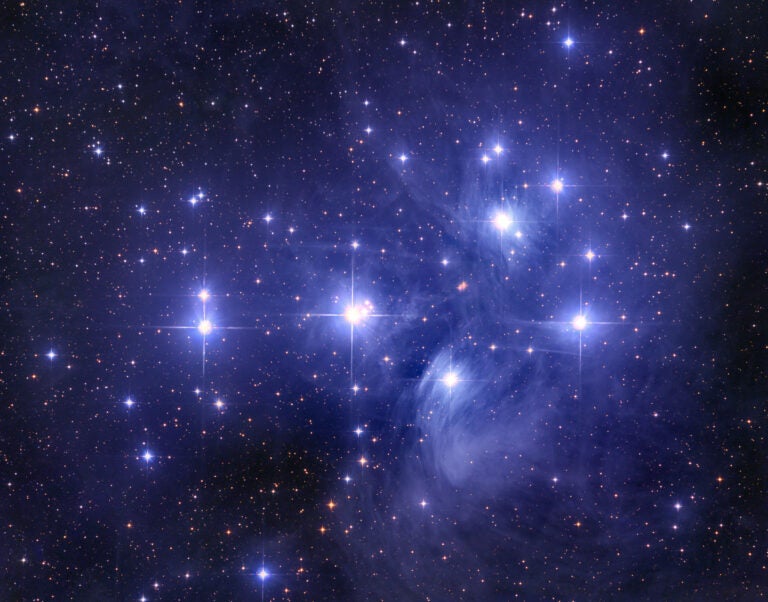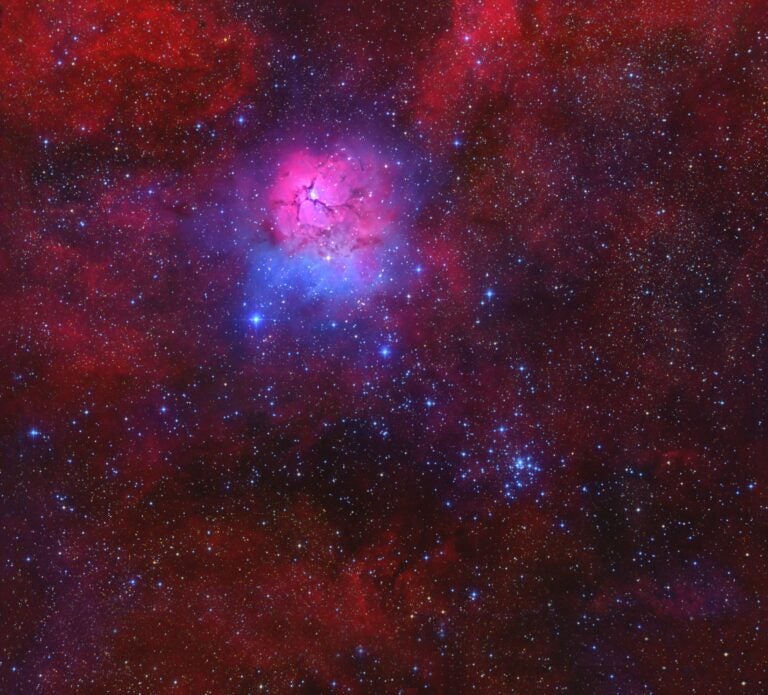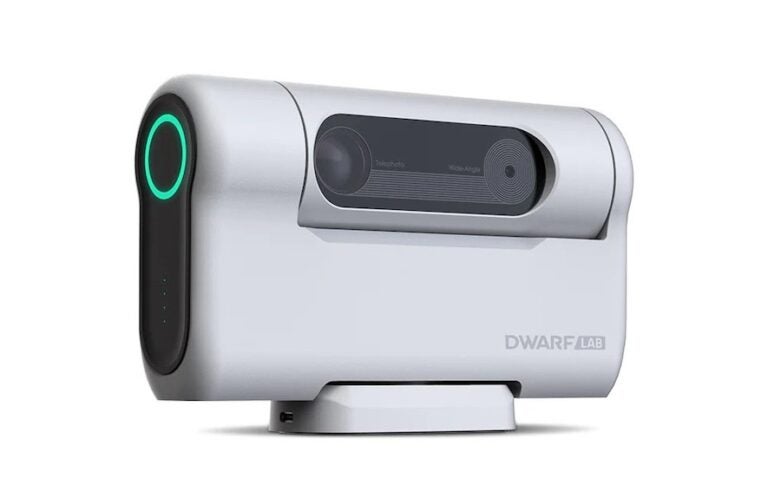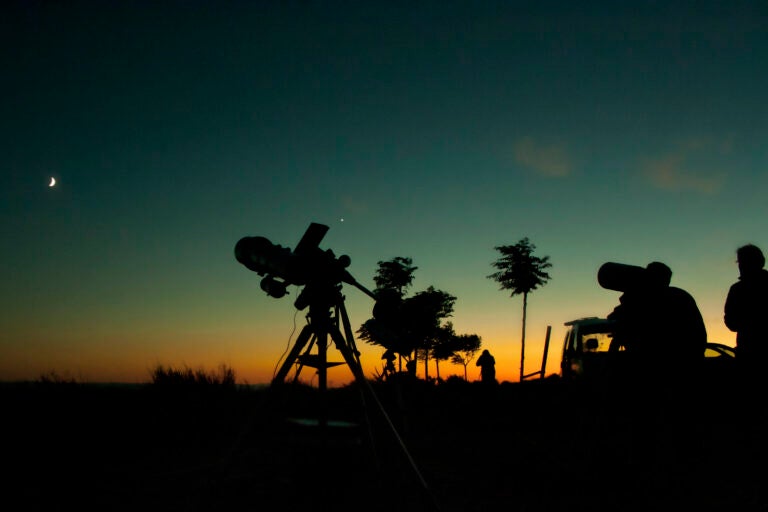I’ve always thought there were too many variables to come up with a rule for determining the maximum usable magnification. The key factors include the optical quality of the telescope and eyepiece; how well collimated (aligned) it is; the observer’s vision; and the seeing (atmospheric steadiness). So, given excellent optics, you may be able to exceed 100x per inch on some nights, while on others, 30x per inch may cause the view to crumble.
Vixen Optics shares this philosophy. Because of all the high-quality telescopes available today, Vixen introduced a series of high resolution (HR) eyepieces aimed at ultra-high magnification. In most of these telescopes, each of the eyepieces violates the conventional wisdom of 60x per inch by a wide margin.
This trio of eyepieces has focal lengths of 2.4mm, 2.0mm, and 1.6mm. Yes, you read that right — an eyepiece with a focal length below 2mm. Vixen created all three for fast, top-end apochromatic refractors and Newtonian reflectors.
In conventional eyepieces, such extreme focal lengths would result in eye relief distances that would be far too short for comfortable viewing. But these are anything but conventional eyepieces. Vixen’s proprietary design provides 10 mm of eye relief in all three. While that can be a bit tight for those who must wear glasses, it is more than adequate for those who don’t. At the same time, the apparent field of view through each is 42°.
Perhaps best of all, Vixen does all this with a minimalist design. As experienced planet-watchers will attest, less is more when it comes to viewing. Many of today’s eyepieces use more than a half-dozen lens elements to render an image. Even with the finest coatings, a little bit of light scatters every time it strikes a lens surface, lowering image contrast and brightness.
The HR eyepieces consist of five elements set in three groups, all with Vixen’s premium AS (Astronomy Special) coatings that claim 99.9 percent transmission. That means the ultimate throughput to the observer’s eye is 99.5 percent of the light entering the eyepiece.
Have you heard of the Strehl ratio? It’s a measure of the quality of an optical image against a theoretically perfect system. The higher the percentage (the closer to 1.0, or 100 percent), the better the optical design and execution. Vixen says the Strehl ratio of each HR eyepiece is 100 percent on-axis and more than 97 percent at the outer edge of the field of view. Numbers like this promise ultra-sharp images.
But there’s more to these eyepieces than just outstanding optics. Vixen’s designers put just as much thought into the mechanical aspects. For instance, the company painted all interior surfaces flat black to stifle unwanted reflections. Even the portion of the barrel top surrounding the eye lens is flat black to squelch any light trying to infiltrate from the side. At the other end of the barrel sits a removable baffle, also to suppress stray reflections. Unscrewing the baffle reveals standard filter threads.
Making full use of these extraordinary eyepieces requires a top-notch telescope on a night of steady seeing. For the scope end of this test, I chose my 10-inch f/5 Newtonian reflector. It consistently produces sharp images at “sane” magnifications within the limits of the 60x-per-inch rule. Would this be the case when pushed beyond its conventional limit?
Waiting for that night of steady seeing proved to be the biggest challenge. In my neck of the woods on Long Island, especially in the early spring when I was testing these, the sky is often a cauldron of turbulence due to fluctuating temperatures and strong winds. Several nights passed with unsatisfactory results until one special night in April.
I set up my telescope in the early evening to allow it to cool to ambient temperature, but I waited until early morning to use it, after the Moon, Jupiter, and Saturn had risen. All were positioned relatively low in the southern sky even when they were at their highest, which made seeing a concern. Fortunately, on this night, everything came together perfectly.
I began by observing the Moon, which was near Last Quarter. As soon as I swapped out one of my long-focal-length eyepieces (which I used to locate the Moon in the field of view) for the 2.4mm HR and took a peek, the only word that came to my mind was “Wow!” Viewing the lunar surface at a whopping 529x defies description. I wasn’t just viewing the Moon; I was practically there orbiting it.
As I toured the lunar surface, I stopped at some of my favorite ports of call, including the crater Copernicus, the Alps and Apennine mountain ranges, and Sinus Iridum. I then swapped the eyepiece for the 2.0mm (635x in my scope) and finally the 1.6mm (794x).
While the views through the 2.4mm were sharp, images through the 2.0mm were not quite as crisp due to the Moon’s low altitude. The image through the 1.6mm was softer still, but incredibly impressive nonetheless. The gradual degradation of image quality is more reflective of my local seeing conditions at the time rather than the optical performance of the eyepieces.
I then moved on to Jupiter. Just the sheer apparent size of the planet was striking. It was huge! The gas giant’s cloud bands were clear, showing subtle details that were not apparent through some of my long-focal-length eyepieces.
Saturn’s rings were even more impressive. The Cassini Division was easy to spot, as was the subtle inner C (Crepe) ring. I suspected seeing the Encke Division, a low-contrast zone in the middle of the A ring.
As I used the eyepieces, their small exit pupils intensified my eyes’ floaters, those black or gray specks and strings that drift through your vision as you move your eyes back and forth. These age-related annoyances were especially apparent when I viewed the Moon.
All three HR eyepieces are nearly parfocal. That means that once you focus one, the others will require little or no refocusing when switching back and forth between them. The 2.0mm and 2.4mm were spot on, while the 1.6mm needed only a minor tweak of the fine focuser knob.
As of this writing, word has it that Vixen is about to add a 3.4mm eyepiece to the HR line. Its optical design, eye relief, and apparent field of view will match the other three.
Power to the people!
I greatly enjoyed my time with these eyepieces. Owing to the seeing where I live, the 2.4mm proved to be my favorite. If I lived in an area that offered consistently better seeing, all three would be equally valuable additions to my eyepiece case.
Do note, however, that these are definitely niche eyepieces. Their relatively narrow apparent fields, coupled with their high magnifications, do not make these the first choice for general viewing. But if you’re searching for high-resolution eyepieces specifically designed for high-power lunar and planetary viewing, then Vixen’s HR eyepieces are the new standard by which all others are judged.

